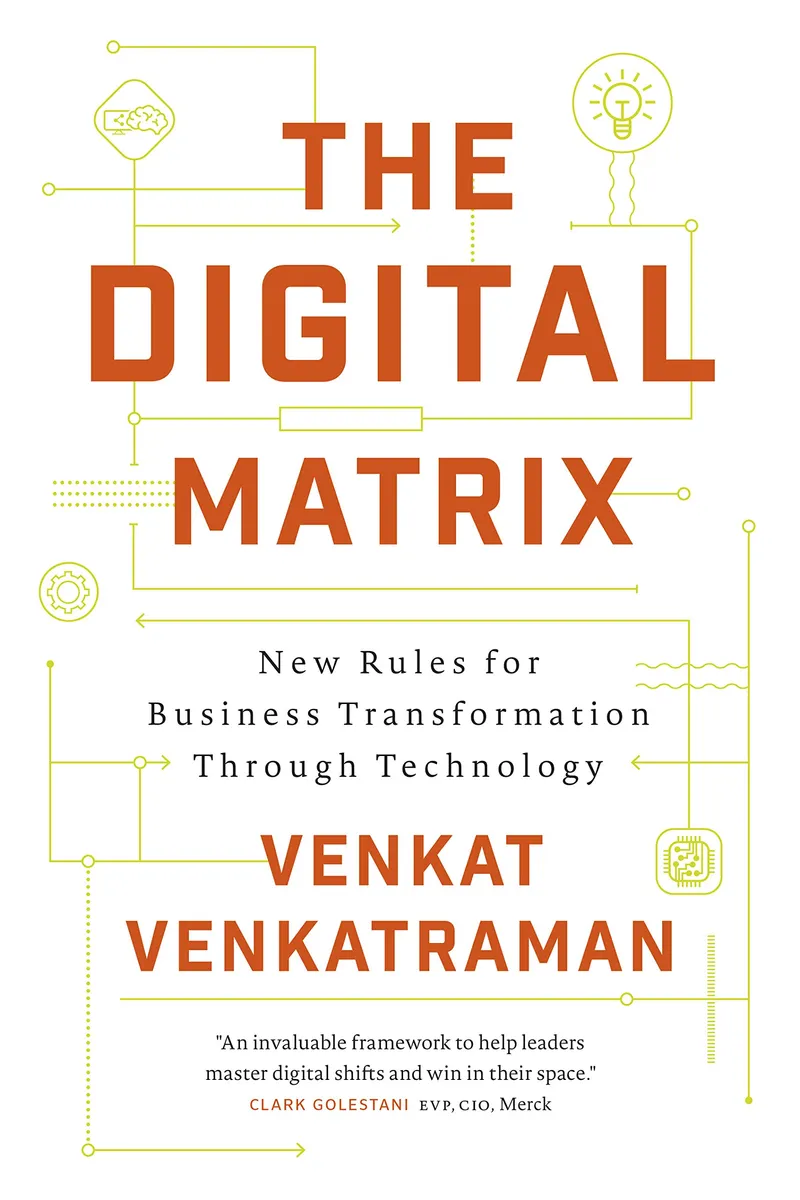

Book review: The Digital Matrix by Venkat Venkatraman
Book review: 'The Digital Matrix' by Venkat Venkatraman
The world is discussing post COVID - 19 crisis recovery. There are predictive models built with scenarios based on V, U shaped recoveries or L shaped protracted challenge[1]
Across all the discussions, there are few imperatives outlined for business leaders during and post COVID - 19 crisis environment. One of the key mandates that appears common across all discussions propounded by think tanks, is to accelerate digital transformation initiatives of companies
Resonating the need to increase the focus on digital transformation, I felt that it is timely to review a book on digital business model
There are various books and articles published in the past few years on digital business models. One of the recent ones is ‘The Digital Matrix’, New rules for business transformation through technology; by Prof Venkat Venkatraman (Author) published by Penguin Random House. Prof Venkat Venkatraman[2] is David J. McGrath Jr. Professor at Boston University Questrom School of Business and specializes in Digital business, Digital strategy and IT strategy

Image credit: www.amazon.in
Though the book is primarily focused on building a guidance framework for an incumbent business to respond to digital disruption, the book covers the moves by digital startups driven by tech entrepreneurs and the digital giants like Google, Amazon and Facebook. The key highlight of the book is the interaction of these players and their actions across the three phases of transformation. As one travels in the digital transformation journey, the book offers ample lessons for all three players to collaborate, identify and build businesses
In this review, I am covering the key aspects that are useful for practice, picking from the various sections of the book. The book documents business stories, compelling case studies that support, explain the principles of transformation proposed by the author
One needs to read the book to be enabled, to practice the principles outlined
Your business is already digital
“There is no alternative to digital transformation. Visionary companies will carve out new strategic options for themselves — those that don’t adapt, will fail.”
— Jeff Bezos, Amazon[3]
Prof Venkat Venkatraman challenges the traditional business models, and dogmas across the book. He outlines two key nexuses that makes the statement ‘world is already digital’ a reality
- Digital is eating the world: Advancement in the field of powerful computing, potent cloud and pervasive connectivity forms a powerful nexus, empowering the digital technologies that are eating the world
- Exponential growth: While the traditional businesses have always been focusing on economies of scale and scope, author introduces the new norm in digital world, 'speed’ driven by technologies. The nexus of scale, scope and speed propels exponential growth
Author explains with real – life examples about these nexuses and emphasizes that one’s business is already digital. One may not be able to sense and embrace digital transformation due to their own making called ‘Success traps’
The Digital Matrix

Image Credit: https://www.pexels.com/photo/abstract-art-blur-bright-373543/
The business world is replete with 2X2 and 3X3 matrices that are prominent in all thought leadership works.
For a change, author introduces a powerful tool called ‘The Digital Matrix’ that is like a motion picture of interactions between three actors and three phases of transformations
The three actors are,
- Industry incumbents like GM, Ford, Toyota in auto industry etc.,
- Startups led by tech entrepreneurs like Paypal and Tesla
- Digital giants like Alphabet, Amazon, Apple etc.,
While industry transformations are the norm, in digital age the pace of these transformations is more rapid. Author identifies three phases of transformation and highlights that an industry incumbent must deftly manage, the actions of the actors and also navigate the three phases of transformation, simultaneously
The three phases of transformation are,
- Experimentation at the edge are the early stage experiments, ranging from far – fetched but incredible ones to realistic, potentially valuable ones. This is a stage, where one needs to be able to sense noise versus signals. For instance, in 2005 when Apple announced the foray into music world by launching iTunes in partnership with Motorola, it might have been a signal to music industry to take note of, but might not have been perceived with the similar impact in telecom industry, then dominated by Motorola, BlackBerry (RIM), Nokia etc.,
- Collision at the core is the next phase, where the ideas have emerged into business options. In 2000, upstarts like Amazon’s effort in e - commerce has moved towards next phase from the early stage of online bookstore in 1994. But, Walmart perceived e - commerce as one more channel, not as a business model. Big - box retailers noted that e - commerce is colliding at their core around 2016, the year in which the market capitalization of Amazon was higher than that of world’s largest retailer in terms of sales and employment, Walmart
- Re invention at the root is the stage, when the boundaries blur and when all three players work together to solve consumers’ core problems using digital functionality. For instance, traditional B2C brand in washing machines, Whirlpool emerging into Internet of Things (IoT) device that uses data on usage patterns and customizes service to consumers in real time. More the data, better the customized solutions, making homes as ‘small hubs of people lives’
Tool for transformation as a motion picture
“When digital transformation is done right, it’s like a caterpillar turning into a butterfly, but when done wrong, all you have is a really fast caterpillar.”
— George Westerman, MIT Sloan Initiative on the Digital Economy [3]
After detailing the players and phases on the digital matrix, Author handholds the reader to self-build customized tools for digital transformation
Author raises few queries and prescribes steps to
- Assess one’s relative position in the matrix
- Identify the phases of the transformation in one’s industry,
- Draft a customized rule book
The introspection will help one to
- Build the role and relevance across the phases of industry transformation
- Assess the distinctive capabilities that the company needs to build the role and relevance in the transformed digital world
- Identify the partnerships, effectively mobilize the resources and be ready to ride the digital wave
Three winning moves

mage credit: Photo by Alex Andrews from Pexels
https://www.pexels.com/photo/three-black-handset-toys-821754/
Author helps with inflection points to identify where is one’s industry positioned across the three phases of transformation
Also, one of the key aspects during this introspection is to identify the business model of your business viz., product, service, solution and platforms. Author explains the business models in adequate detail and highlights the inevitable rise of platform business models in digital world
Emergence of ecosystems versus the traditional supply chain is one of key factors of digital business world and hence author explains to identify, build or partner to collaborate and also to compete in the ecosystems
Author underlines the need to redesign one’s approach to work in digital world. He emphasizes that integration and interaction of technology in work will play a vital role in digital transformation. He highlights the need to use technology not only to automate, but also to augment and to amplify the businesses
The three winning moves that the author explains in detail along with examples are,
- Orchestrate and participate across ecosystems
- Collaborate and Co Create new capabilities
- Amplify your human talent with powerful machines
These sections are vital to draft practical guidelines to one’s business transformation
Digital rules matrix and gap score
Prof Venkat Venkatraman takes a role of a guide by offering tools to introspect the role, relevance, competencies to
- Observe and invest during experimentation at the edge phase
- Co –exist and morph during collision at the core phase
- Frame and solve problems during reinvention at the root phase
Based on the narratives, author lists nine rules, guides one to evaluate, score one’s the proficiency against the rule and to identify the gap score
This gives a quantifiable idea on the position, the urgency to act and list actionable steps to be taken
Time to think and re-imagine the business models
“The biggest part of our digital transformation is changing the way we think.”
— Simeon Preston, Bupa [3]
As Author explains in the initial sections of the book, the success of the traditional companies itself becomes the trap and hinders or slows down the digital transformation efforts
But the current pandemic may unleash a new normal in the world economic order, the way humans communicate, and the way one does business etc., The current pause in business triggered by the COVID – 19 pandemic, has offered an opportunity to business leaders to think and re-imagine the business models. Digital technologies being the key enabler, this is high time to accelerate digital transformation initiatives
The book Digital Matrix is a good companion for the journey.







